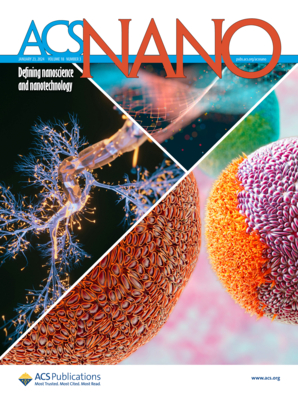Design of Zn Chalcogenide Shells for Emissive Ga-Rich In1–XGaXAs Quantum Dots Synthesized in Molten Salts
IF 16
1区 材料科学
Q1 CHEMISTRY, MULTIDISCIPLINARY
引用次数: 0
Abstract
Colloidal quantum dots (QDs) have seen expanded applications in optoelectronics from visible to near-infrared (NIR) wavelengths. However, the options for QDs with bright and size-tunable emission in the NIR region are mostly limited to heavy-metal-based (Pb, Cd, Hg) semiconductors. Here, Ga-rich In1–XGaXAs QDs with zinc chalcogenide shells are demonstrated as candidates for NIR emitters. Based on new developments in inorganic molten salt chemistry, we synthesized colloidal In1–XGaXAs QDs containing up to 85% gallium with high crystallinity based on Raman and XRD analyses. Zinc selenide and sulfide shells with different morphologies were grown on In1–XGaXAs QDs by controlling the Zn precursor chemistry. Despite the nominally reduced lattice mismatch in the In1–XGaXAs/ZnSe heterostructure, a ZnS shell was found to be a much more effective passivation material: In1–XGaXAs/ZnS core–shell QDs show a photoluminescence quantum yield (PL QY) of about 30% versus 11% for ZnSe shells. Based on the analysis of PL decay and transient absorption (TA) dynamics, we surmise that electron trapping is the major reason for efficiency loss, providing a clear heterostructure design principle for realizing efficient NIR-emitting In1–XGaXAs QDs.

熔盐合成富ga发射型In1-XGaXAs量子点的硫系锌壳设计
胶体量子点(QDs)在光电子领域的应用已经从可见光扩展到近红外(NIR)波长。然而,在近红外区域具有明亮和尺寸可调发射的量子点的选择主要限于重金属基(Pb, Cd, Hg)半导体。在这里,富含ga的含有硫族锌壳层的In1-XGaXAs量子点被证明是近红外发射体的候选者。基于无机熔盐化学的新进展,我们基于拉曼和XRD分析合成了含高达85%镓的胶体In1-XGaXAs量子点。通过控制Zn前驱体的化学性质,在In1-XGaXAs量子点上生长出了不同形貌的硒化锌和硫化锌壳。尽管名义上减少了In1-XGaXAs /ZnSe异质结构中的晶格错配,但ZnS壳层被发现是一种更有效的钝化材料:In1-XGaXAs /ZnS核壳量子点的光致发光量子产率(PL QY)约为30%,而ZnSe壳层为11%。基于PL衰减和瞬态吸收(TA)动力学分析,我们推测电子俘获是导致效率损失的主要原因,为实现高效nir -发射In1-XGaXAs量子点提供了明确的异质结构设计原则。
本文章由计算机程序翻译,如有差异,请以英文原文为准。
求助全文
约1分钟内获得全文
求助全文
来源期刊

ACS Nano
工程技术-材料科学:综合
CiteScore
26.00
自引率
4.10%
发文量
1627
审稿时长
1.7 months
期刊介绍:
ACS Nano, published monthly, serves as an international forum for comprehensive articles on nanoscience and nanotechnology research at the intersections of chemistry, biology, materials science, physics, and engineering. The journal fosters communication among scientists in these communities, facilitating collaboration, new research opportunities, and advancements through discoveries. ACS Nano covers synthesis, assembly, characterization, theory, and simulation of nanostructures, nanobiotechnology, nanofabrication, methods and tools for nanoscience and nanotechnology, and self- and directed-assembly. Alongside original research articles, it offers thorough reviews, perspectives on cutting-edge research, and discussions envisioning the future of nanoscience and nanotechnology.
 求助内容:
求助内容: 应助结果提醒方式:
应助结果提醒方式:


